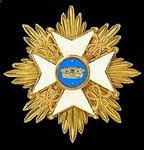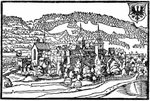As I have not posted for over two weeks here is one more interim offering; another of the stray Minden French flags, which is one of my favourites. I do have a number of Prussian flags waiting in the queue but having to find time to write accompanying regimental histories to go with the flags does inevitably slow me down! Once again I also offer my translation of Susane's Francophile history of the regiment in the Seven Years War.
Dauphin was first raised in 1667 by Louis XIV as his son the Dauphin's own regiment. At the beginning of the Seven Years War it had two battalions.
Thus is my translation of the text from Susane volume 4:
In 1756, it was part of the La Hougue camp, and was in Toul in March 1757 when it received orders to join the army of the Marshal d'Estrées, then encamped under Wesel. It entered the landgraviate of Hesse and, after a short stay in Cassel, it rejoined this army, which had just invaded Hanover after the victory of Hastenbeck. It took part in all the actions of that expedition, and on the 25th of December found itself involved in the forcing of the line of the river Aller. At the beginning of 1758 it was in the rearguard of Marshal de Broglie's army during his retreat towards the Rhine. It spent this year in Hanau and had its winter quarters in Friedberg. In 1759 it was at the siege of Munster, and fought vigorously at the Battle of Bergen, where it remained from ten in the morning until night under formidable artillery fire. That day it had more then 200 men put out of action, and among the dead were the captains Chaponnay, de Gray, Montullé and Connezac, and three lieutenants. Dauphin again suffered greatly from artillery fire at the Battle of Minden, August 1st: there 150 men were killed or wounded. Captain de Panis and Lieutenant de Longeville were among the killed.
In 1760 it found itself at the affair of Corbach but took no part in it, having arrived too late to enter the line of battle. At the end of July, it helped to force Prince Ferdinand out of his position of Sachsenhausen; it also fought at Warburg, and after taking part in all the movements that marked the end of that punishing campaign, it wintered at Fulde. In the spring of 1761, the regiment took up its post at Hiersfeld. Sergeant Sans-Souci, in charge of fifteen men guarding a fodder depot, defended himself for a long time against a numerous body of enemy light troops; he managed to retreat but during the action he unfortunately suffered a mortal wound. The battles of Villingshausen were the only important events of this campaign. The regiments of the King and the Dauphin took the honours. Hurried together to help the Deux-Ponts brigade, which had seized the village of Villingshausen but was struggling to maintain the position, they fought fiercely throughout the day against the whole corps of Lord Granby and did not give in until they saw they were alone on the battlefield. On this day, almost all the grenadiers and chasseurs of Dauphin were killed, wounded or taken prisoner. The captain La Clos perished there. The regiment left the army in the month of October and was sent to Dunkirk to recover from its losses. It reappeared in 1762 in Germany and was part of the reserve under the orders of the Prince of Condé. It found itself at the bombardment of Ham, and its companies of grenadiers and chasseurs were part of an expedition to Osnabrück, which was the last operation of the war in this theatre. Dauphin returned to Dunkirk; and it was there that it incorporated, on February 15, 1763, the former regiment of Guyenne, a battalion of which had performed so well in the war in Canada.
And here is the uniform plus flags from the 1757 MS:



















